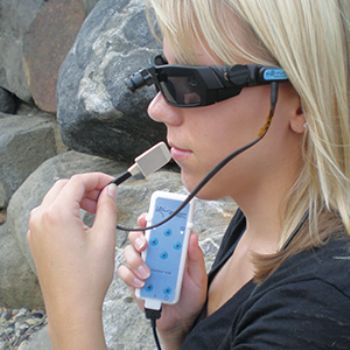
Wisconsin-based Wicab Inc (
www.wicab.com) has received FDA marketing approval for BrainPort, a non-invasive device that allows people who are blind to sense visual images using their tongue. The device converts images into electrical impulses that are felt on the tongue as vibrations or tingling sensations.
When used with a cane or assistance dog, the BrainPort V100 can enhance people’s ability to navigate their environment by ‘tasting the light’.
It looks like a square plastic lollipop that goes into the mouth and sits on the tongue; it is connected via a wire to a tiny video camera mounted on a pair of sunglasses that the user wears.
The video camera captures images that are converted to electrical impulses, and then sent to electrodes in the lollipop. After receiving training, and with experience, the user learns to interpret the signals through their tongue and determine the size, shape and position of objects in front of them — and even recognise if they are moving.
The technology behind the BrainPort was first developed by American neuroscientist Dr Paul Bach-y-Rita, who died in 2006, having pioneered a new field in ‘brain plasticity’. He introduced the concept of ‘sensory substitution’, where signals from one sense are fed into the brain circuits of another, and he developed it as an approach for treating patients with disabilities.
Bach-y-Rita’s idea is that we see the world with our brains and not our eyes — our eyes are merely the sensors. If the sensor is damaged or stops working, then you can use another sensor to get the visual information to the brain.
Robert Beckman, Wicab president and CEO, says that one of the advantages of the BrainPort is its simplicity. Another is the fact that it does not affect the user’s eyes, so they can benefit from future medical advances — for instance, in stem cell research.
William Maisel, the FDA’s deputy director for science, said: “Medical-device innovations like this have the potential to help millions of people.”